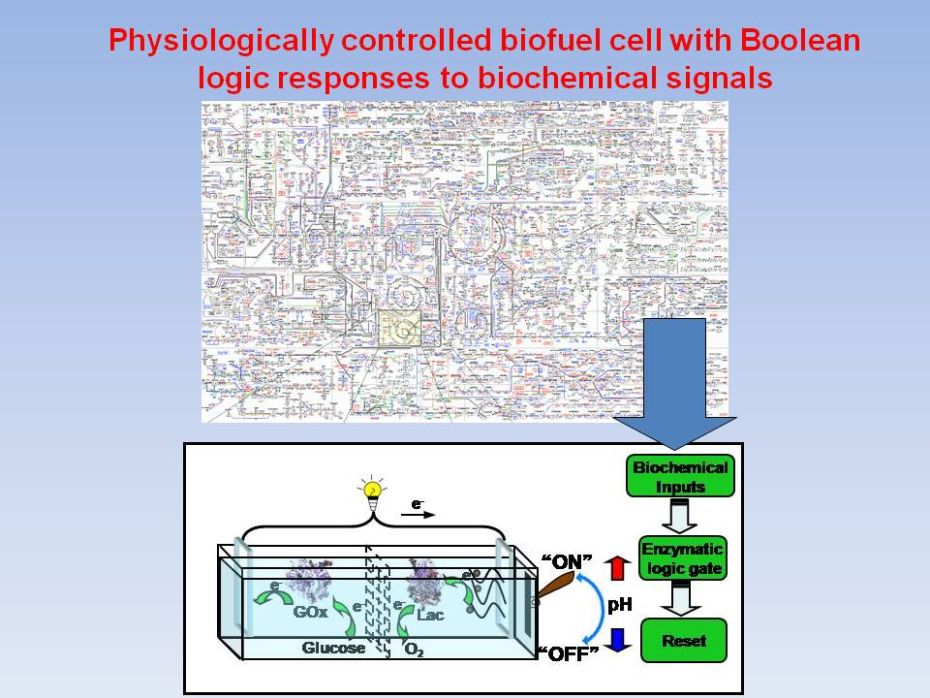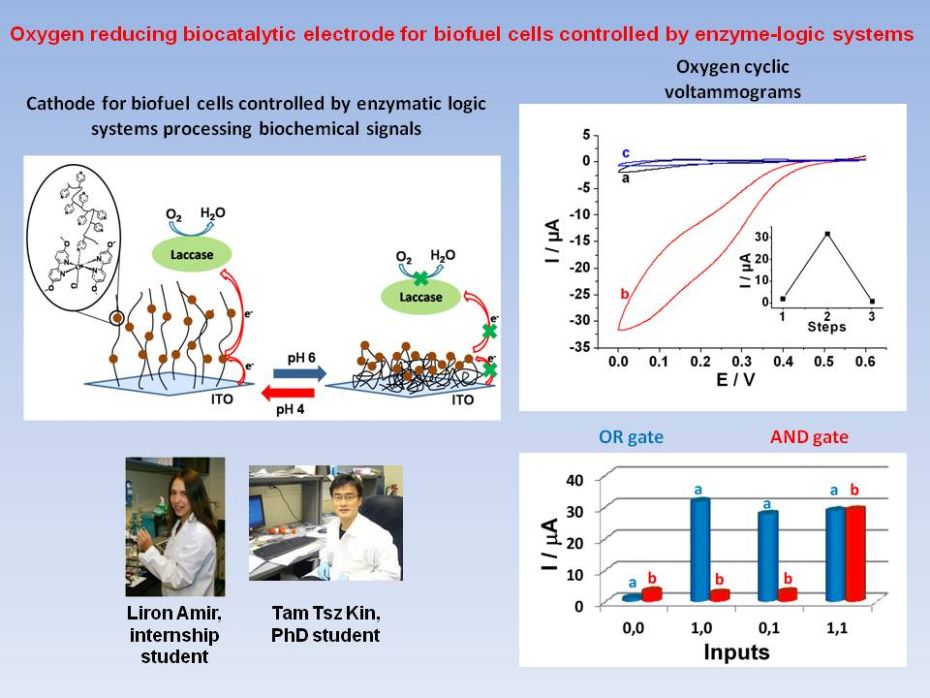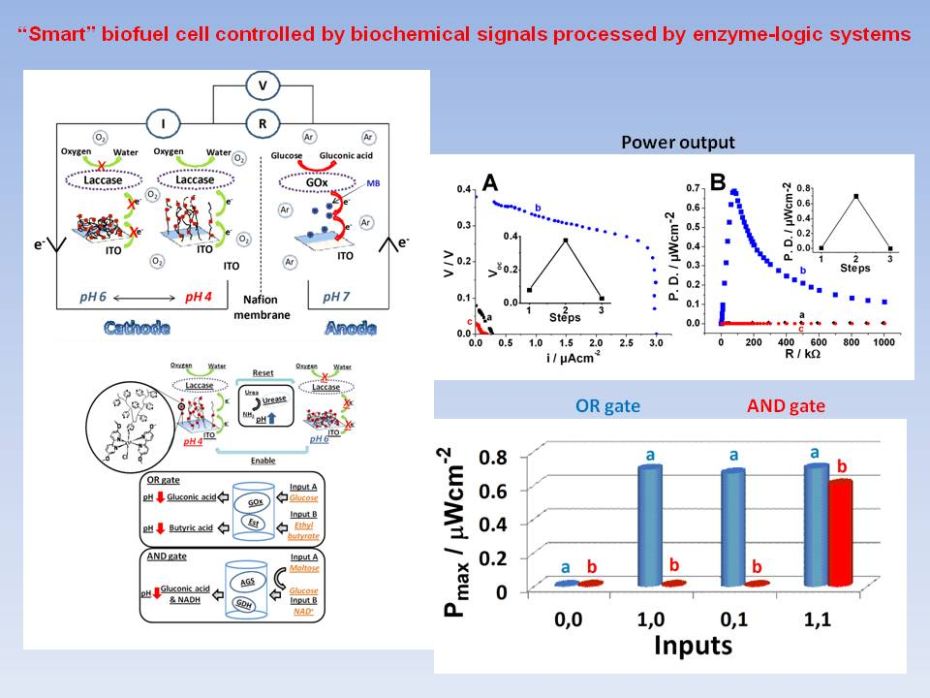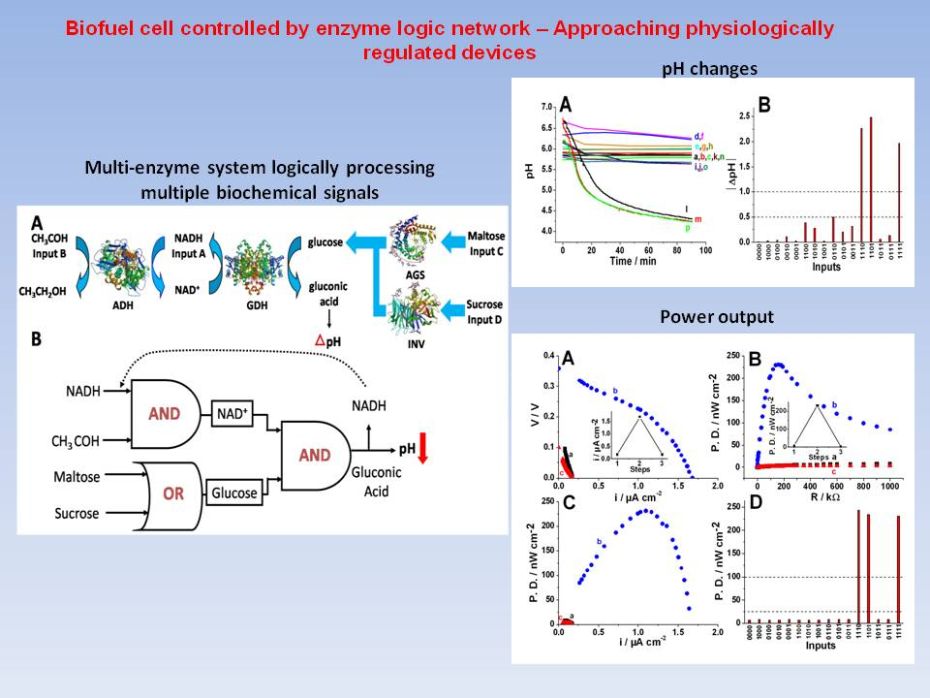
E. Katz, M. Pita, Biofuel cells controlled by logically processed biochemical signals: Towards physiologically regulated bioelectronic devices. (Concept paper) Chem. Eur. J. 2009, 15, 12554-12564.
 |
Biofuel cells with switchable power
release controlled by biochemical signals logically processed by
biomoleculer computing systems have been designed. The switchable
properties of the biofuel cells were based on the
polymer-brush-modified electrodes with the activity dependent on the
solution pH value. The pH changes generated in situ by biocatalytic
reactions allowed the reversible activation – inactivation of the
bioelectrocatalytic interfaces, thus affecting the activity of the
entire biofuel cells. Boolean logic operations performed by either
enzymes- or immuno-based systems were functionally integrated with the
switchable biocatalytic process allowing logic control over them.
Scaling up the complexity of the biocomputing systems to complex
multi-component logic networks with built-in “program” resulted in the
control of the bioelectronic systems by multi-signal patterns of
biochemical inputs. Future implantable biofuel cells producing
electrical power on-demand depending on physiological conditions are
feasible as the result of the present research. E. Katz, M. Pita, Biofuel cells controlled by logically processed biochemical signals: Towards physiologically regulated bioelectronic devices. (Concept paper) Chem. Eur. J. 2009, 15, 12554-12564. |
 |
Biofuel Cell Controlled
by Enzyme Logic Systems
An enzyme-based biofuel cell with a
pH-switchable oxygen electrode, controlled by enzyme logic operations
processing in situ biochemical input signals, has been developed. Two
Boolean logic gates (AND / OR) were assembled from enzyme systems to
process biochemical signals and to convert them logically into
pH-changes of the solution. The cathode used in the biofuel cell was
modified with a polymer-brush functionalized with Os-complex redox
species operating as relay units to mediate electron transport between
the conductive support and soluble laccase biocatalyzing oxygen
reduction. The electrochemical activity of the modified electrode was
switchable by alteration of the solution pH value. The electrode was
electrochemically mute at pH > 5.5 and it was activated for the
bioelectrocatalytic oxygen reduction at pH < 4.5. The sharp
transition between the inactive and active states was used to control
the electrode activity by external enzymatic systems operating as logic
switches in the system. The enzyme logic systems were decreasing the pH
value upon appropriate combinations of the biochemical signals
corresponding to the AND / OR Boolean logic. Then the pH-switchable
electrode was activated for the oxygen reduction and the entire biofuel
cell was switched ON. The biofuel cell was also switched OFF by another
biochemical signal which resets the pH value to the original neutral
value. The present biofuel cell is the first prototype of a future
implantable biofuel cell controlled by complex biochemical reactions to
deliver power on-demand responding in a logic way to the physiological
needs.
L. Amir, T.K. Tam, M. Pita, M.M. Meijler, L. Alfonta, E. Katz, J. Am. Chem. Soc. 2009, 131, 826-832. |
 |
 |
 |
Biofuel Cell Controlled
by Enzyme Logic Network – Approaching Physiologically Regulated Devices
A
“smart” biofuel cell switchable ON
and OFF upon application of several chemical signals processed by an
enzyme logic network was designed. The biocomputing system performing
logic operations on the input signals was composed of four enzymes:
alcohol dehydrogenase (ADH), amyloglucosidase (AGS), invertase (INV)
and glucose dehydrogenase (GDH). These enzymes were activated by
different combinations of chemical input signals: NADH, acetaldehyde,
maltose and sucrose. The sequence of biochemical reactions catalyzed by
the enzymes models a logic network composed of concatenated AND / OR gates. Upon application of
specific “successful” patterns of the chemical input signals, the
cascade of biochemical reactions resulted in the formation of gluconic
acid, thus producing acidic pH in the solution. This resulted in the
activation of a pH-sensitive redox-polymer-modified cathode in the
biofuel cell, thus, switching ON the entire cell and dramatically
increasing its power output. Application of another chemical signal
(urea in the presence of urease) resulted in the return to the initial
neutral pH value, when the O2-reducing cathode and the
entire cell are in the mute state. The reversible
activation-inactivation of the biofuel cell was controlled by the
enzymatic reactions logically processing a number of chemical input
signals applied in different combinations. The studied biofuel cell
exemplifies a new kind of bioelectronic devices where the bioelectronic
function is controlled by a biocomputing system. Such devices will
provide a new dimension in bioelectronics and biocomputing benefiting
from the integration of both concepts.
T.K. Tam, M. Pita, M. Ornatska, E. Katz, Bioelectrochemistry 2009, 76, 4-9. |
